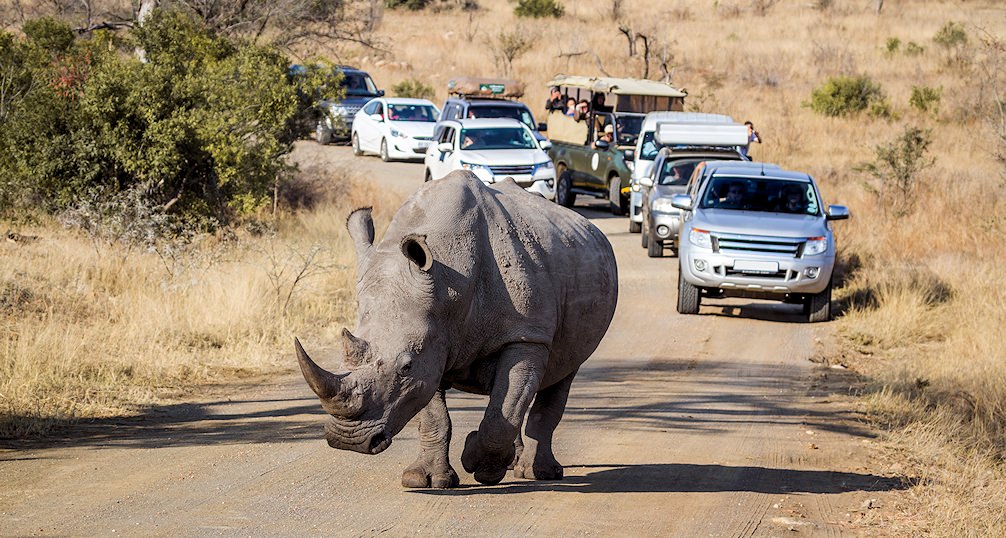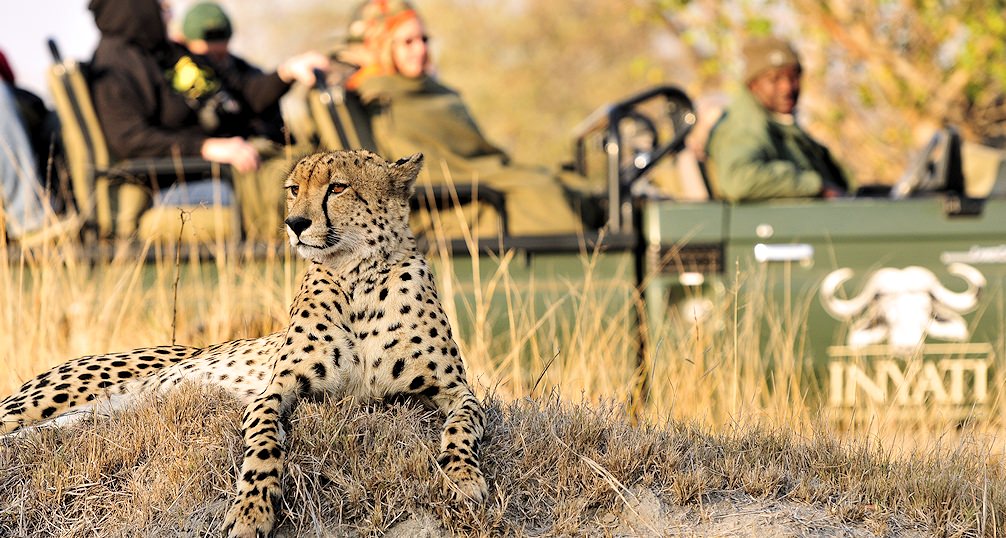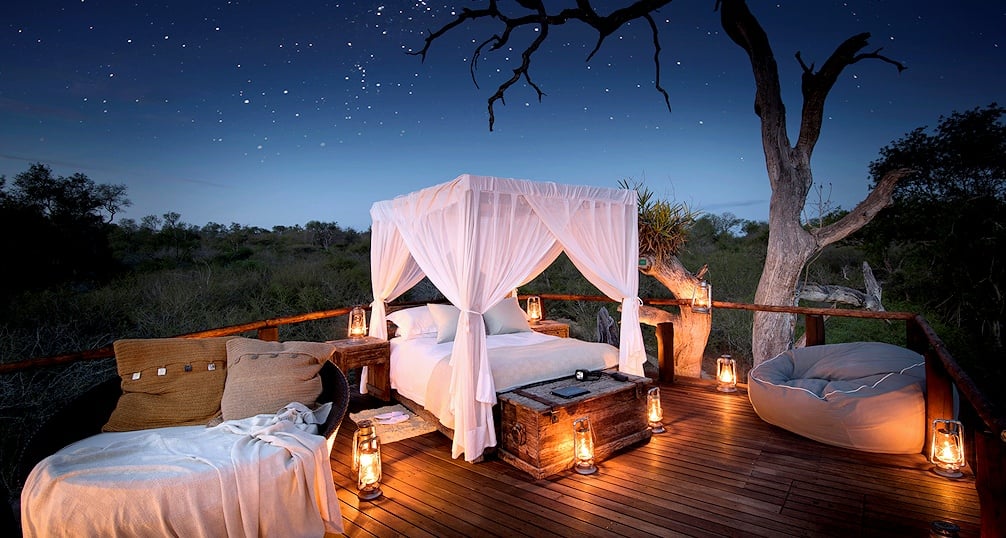Private safari lodge vs standard national park rest camp

The key differences between staying in a lodge or a rest camp on a safari in Kruger or Etosha.
You’re planning to go on safari in Africa. What’s the difference between a private lodge and reserve, and a national park such as Kruger or Etosha? Is one better than the other? It’s prudent to acquaint oneself with the differences before making a decision. Your budget is of course a key factor. The standard of accommodation is obviously an important consideration, and it follows that it’ll influence the standard and quality of meals. How game drives are conducted is another important component. Let’s elaborate on why these aspects are important.

Accommodation Choices
In general, safari accommodations are comparatively expensive. There are good reasons for that. The ongoing logistical groundwork necessary to offer the every-day luxuries we expect – electricity, quality running water, satisfactory meals, internet connectivity, an experienced staff compliment – are expensive to sustain in remote locations. In some regions supplies must be flown in.
Your budget – or how much you’re willing to spend, determines the standard. At the lowest price-point the accommodation (Kruger and Etosha) is best described as rustic. Their offerings meet basic needs but are not luxurious. At the opposite end of the spectrum are exclusive, top-end private lodges, complete with ultra-luxurious suites with every possible amenity, world-class chefs and privately guided game drives.
Kruger and Etosha National Parks offer rustic personal accommodations in one or more of their rest camps. Their brick-and-mortar chalets, with thatched roofs in Kruger, offer two or three single beds, an en-suite bathroom with shower and toilet, wash basin with mirror, hot running water, electricity and air-conditioning. The majority have a small veranda, fridge and barbecue area. Guest cottages and houses, and improved chalets along the perimeter, are available if one wishes to upgrade to a slightly higher standard.
The minimum standard of most private lodges is personal, while the highest standard could be considered exclusive top-end. Private safari lodges offer double, twin and single accommodations. A select few offer family suites. Some can be booked on an exclusive-use basis. Lodges take the form of brick buildings or luxury safari tents, sometimes built on wooden platforms. A few offer tree-house suites, serviced by but located away from the lodge for complete privacy. Most lodges are aesthetically designed to blend into the environment. Nearly every lodge is air-conditioned. King-sized beds are a standard fitting. Most safari lodges make extensive use of roof thatching. The standard of safari lodge accommodations range from very comfortable to ultra-luxurious, and in most cases they make use of the best quality fittings available.

Location, Wildlife, Game Drive Activities
If the standard of accommodation isn’t of paramount importance, your primary focus should fall to possible wildlife sightings and the duration of included game drives. Viewing wildlife is your primary reason for visiting. It makes perfect sense therefore to place yourself in a reserve conducive to those conditions. The rule of thumb is simple: the more one game drives the more remarkable and numerous the sightings are.
The size of the reserve - private or national park, plays a pivotal role. The larger the reserve the larger the wildlife populations are. Bigger reserves imply a greater diversity of species. The benefits of such conditions are obvious.
The volume of traffic at notable sightings is a point requiring clarification. In national parks such as Kruger there will in general be more vehicles present. The majority of such occurrences transpire on main roads, which are paved in Kruger. Off the beaten track along unpaved roads congestion is distinctly less frequent. Traffic congestion in private reserves isn’t as frequent, but still occurs. Exclusive high-end lodges such as Mala Mala Rattray’s make a concerted effort to minimize congestion to three or four vehicles. Even so, Mala Mala has three lodges, and at special sightings you will encounter more than that. With a few exceptions, lodges in private reserves share territories with neighbors, thereby expanding their traversing range. Sharing territories means more vehicles, leading to congestion at notable sightings. Congestion is well managed, but it does limit your time at the sighting, particularly if the animal appears to intend moving on.

National Park Game Drives
If you’re overnighting in the Kruger National Park, or a government reserve such as Etosha, Hluhluwe-iMfolozi or Addo, African Sky provides a private safari guide and vehicle. Our guides are nationally registered, the highest level possible. They’ve conducted safaris for many years and are at least as knowledgeable as the rangers at respected private lodges. In Kruger, we’ll supply a closed, air-conditioned vehicle. Your game drives could last all day if you wish (your guide will discuss the details with you on the day) and could cover a vast portion of the park, up to 150 miles. The only limitation is that you must return by sunset when the gates close. When one considers the distances covered on game drives, closed vehicles are the obvious choice. They offer air-conditioning during our hot and humid summer months, heating in winter, and protection from rain, wind and dust on unpaved roads. That’s particularly important if you’re a photographer traveling with expensive photography equipment.

Private Lodge Game Drives
At private lodges game drives are conducted using open-air 4x4 vehicles. Generally speaking, children under the age of six – if the lodge accepts children - are not permitted on drives, although there are a few exceptions. Depending on lodge location the vehicle might be completely open or will have a canvas roof. Vehicle configurations differ slightly from one region or country to the next. The ranger, also the driver, is assisted by a tracker who sits on a jockey seat attached to the very front of the vehicle. Typical 4x4 safari vehicles carry up to nine passengers in three rows, three seats to a row. You’ll share the vehicle with other guests. If there are more than six guests then those seated in the middle of a row will not have a ‘window’ seat. High-end lodges (Mala Mala Rattray’s, Lion Sands Ivory Lodge, Dulini, Londolozi Tree Camp, etc.) restrict the number of guests on a game drive vehicle to six or even four. Some lodges offer a private game drive vehicle at an additional cost, but only if a vehicle is available. All private lodge game drive schedules are fixed. They’ll conduct two drives daily, one in the early morning and one in the late afternoon leading into evening (when it becomes a night drive).
Drives typically last three to four hours, the duration of which is influenced in part by the weather and sightings. The remainder of your time is spent relaxing at the lodge. Most lodges also offer an optional bush walk during the warmer part of the day, also guided by a lodge ranger and tracker.










